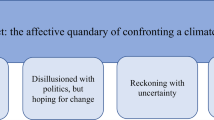Abstract
The failure to anticipate the public's response to environmental problems can lead to expensive delays, bad public relations, and litigation, as well as environmental decisions that do not represent public values and preferences. This study examines the influence of conflict between management goals, perceived resource scarcity, and information bias on evaluations of the importance of management goals; the perception of conflicts among the goals; and the emotions evoked in an urban forest management problem. Environmental problem scenarios were systematically manipulated as to the level of conflict between development and natural preservation goals, the scarcity of urban nature, and the bias of the presented information. Evaluations of the importance of urban nature and economic development were susceptible to manipulations of scarcity. The importance of urban nature was also higher when information was biased toward pro-preservation issues. Negative emotions were associated with high conflict and scarcity and with the propreservation information bias. Both evaluations of goal importance and conflict among goals appeared to be based on an underlying economics-versus-amenity dimension. These results are similar to previous studies of environmental decision making with regard to nonurban environmental problems. This research offers a beginning in understanding and anticipating the way members of the public may respond to information about environmental problems.
Similar content being viewed by others
Literature cited
Becker, R. H. 1983. Opinions about clear-cutting and recognition of clear-cuts by forest recreation visitors.Journal of Environmental Management 17:171–177.
Cotgrove, S. 1982. Catastrophe or cornucopia. Wiley, New York.
Creighton, J. 1983a. An overview to the research conference on public involvement and social impact assessment. Pages 1–10,in G. A. Daneke, M. W. Garcia, and J. Delli Priscoli (eds.), Public involvement and social impact assessment. Westview Press, Boulder, Colorado.
Creighton, J. 1983b. The use of values: Public participation in the planning process. Pages 143–160,in G. A. Daneke, M. W. Garcia, and J. Delli Priscoli (eds.), Public involvement and social impact assessment. Westview Press, Boulder, Colorado.
Daniel, T. C., and R. M. Boster. 1976. Measuring landscape esthetics: The scenic beauty estimation method. USDA Forest Service Research Paper RM-167. Rocky Mountain Forest and Range Experiment Station, Fort Collins, Colorado.
Gardner, P. D., H. J. Cortner, K. F. Widaman, and K. J. Stenberg. 1985. Forest-user attitudes toward alternative fire management policies.Environmental Management 9:303–312.
Heberlein, T. A. 1976. Some observations on alternative mechanisms for public involvement: The hearing, public opinion poll, the workshop and the quasi-experiment.Natural Resources Journal 16:197–212.
Henning, D. H. 1987. Wilderness politics: Public participation and values.Environmental Management 11:283–293.
Izard, C. E. 1972. Patterns of emotions: A new analysis of anxiety and depression. Academic Press, New York.
Janis, I. L., and L. Mann. 1977. Decision making: A psychological analysis of conflict, choice, and commitment. The Free Press, New York.
Miller, A. 1984/1985. Psychosocial origins of conflict over pest control strategies.Agriculture, Ecosystems and Environment 12:235–251.
Orne, M. T. 1969. Demand Characteristics and the concept of quasi-controls. Pages 147–181,in R. Rosenthal and R. L. Rosnow (eds.), Artifact in behavioral research. Academic Press, New York.
Schroeder, H. W. 1981. The effect of perceived conflict on evaluations of natural resource management goals.Journal of Environmental Psychology 1:62–72.
Toda, M. 1980. Emotion and decision making.Acta Psychologica 45:133–155.
Vining, J. 1987. Environmental decisions: The interaction of emotion, information, and decision context.Journal of Environmental Psychology 7:13–30.
Wood, C. J. B. 1977. The use of threat in community decision-making: The Goldstream case, Victoria, B.C. Pages 71–88,in W. R. D. Sewell and J. T. Coppock (eds), Public participation in planning. John Wiley, London.
Zube, E. H., and D. E. Simcox. 1987. Arid lands, riparian landscapes, and management conflicts.Environmental Management 11:529–535.
Author information
Authors and Affiliations
Rights and permissions
About this article
Cite this article
Vining, J., Schroeder, H.W. The effects of perceived conflict, resource scarcity, and information bias on emotions and environmental decisions. Environmental Management 13, 199–206 (1989). https://doi.org/10.1007/BF01868366
Issue Date:
DOI: https://doi.org/10.1007/BF01868366




